Create successful ePaper yourself
Turn your PDF publications into a flip-book with our unique Google optimized e-Paper software.
INSTALLATION / MONTAGE <strong>CAVALLY</strong>-<strong>VM</strong><br />
D<br />
INSTALLATION / ASSEMBLY <strong>CAVALLY</strong>-<strong>VM</strong><br />
GB<br />
Die Installation und Inbetriebnahme Ihres Designheizkörpers<br />
<strong>CAVALLY</strong>-<strong>VM</strong> ist von einer zugelassenen Fachfirma durchzuführen.<br />
Bei der Installation sind die einschlägigen Normen bzw. die nationalen<br />
elektrotechnischen Sicherheitsvorschriften wie ÖVE- und<br />
VDE-Bestimmungen zu beachten. Unter Berücksichtigung der<br />
geometrischen Maße des Designheizkörpers <strong>CAVALLY</strong>-<strong>VM</strong> und<br />
der Anschlussarmatur ist die Verrohrung vorzubereiten (siehe<br />
Abb. 1 und Abb. 3).<br />
Wir empfehlen einen seitlichen Mindestabstand zum Heizkörper von<br />
100 mm einzuhalten. Dabei ist Nachfolgendes zu berücksichtigen.<br />
Wird ein Elektroheizelement verwendet, kann dieses in eine der<br />
beiden 1/2" Muffen I eingedichtet werden. Dabei sind die Hinweise<br />
der Montageanleitung für das PTC-Elektroheizelement zu<br />
beachten.<br />
Vor der Wandmontage des Heizkörpers ist zu beachten<br />
(siehe Abb. 3):<br />
Der Vorlaufanschluss befindet sich links von der Mitte des<br />
Designheizkörpers.<br />
Your design radiator <strong>CAVALLY</strong>-<strong>VM</strong> must be installed and <strong>com</strong>missioned<br />
by an authorised <strong>com</strong>pany. The applicable standards and<br />
national electrotechnical safety regulations such as the ÖVE and<br />
VDE regulations must be observed for installation. Prepare the<br />
pipework, taking into account the geometric dimensions of the<br />
design radiator <strong>CAVALLY</strong>-<strong>VM</strong> and the connector (see Abb. 1 and 3).<br />
We re<strong>com</strong>mend keeping a minimum lateral clearance of 100 mm<br />
from the radiator, whereby the following should be noted.<br />
If an electrical heater cartridge is used it may be sealed in one of<br />
the two 1/2" sleeves l. It is important that the instructions contained<br />
in the PTC-Electrical heating assembly instructions are <strong>com</strong>plied<br />
with.<br />
Before mounting the radiator on the wall, (see Abb. 3):<br />
Please note that the flow pipe fitting is to the left of the centre of<br />
the valve pipe.<br />
WANDMONTAGE:<br />
Aufstecken der beigepackten Blechmuttern 1 auf die Montagestutzen<br />
2 (Abb. 2).<br />
Anreißen, bohren der Löcher Position A - Bohrer ø10 - und setzen<br />
der Dübel entsprechend den Aufhängungsmaßen - (Abb. 1). Für<br />
eine sehr solide Wandmontage wird empfohlen, auch die Wandfüße<br />
Position B an die Wand zu schrauben. Erfolgt dies nicht, dann<br />
dienen die Wandfüße Position B als Distanzierungen.<br />
Empfehlung:<br />
Messen Sie bitte vorher zur Heizkörperidentifizierung die Abstandsmaße<br />
der Montagestutzen 2 (Abb. 1 u. Abb. 2) nach.<br />
Nach Bedarf (Wandbeschaffenheit) sind die beigepackten Kunststoffbeilagen<br />
3 auf die Wandfüße 4 zu kleben (Abb. 2). Bitte auf<br />
saubere Klebestellen achten.<br />
Befestigung der oberen und eventuell unteren Wandfüße 4 und<br />
diese waagrecht bzw. senkrecht ausrichten, wobei die Senklochbohrungen<br />
5 in den Wandfüßen nach außen stehen müssen.<br />
Dabei sollen die Wandmontageschrauben 6 in der Mitte der Langlöcher<br />
der Wandfüße montiert werden. (Es wird empfohlen, die<br />
Abstandsmaße der montierten Wandfüße vor der Heizkörperwandmontage<br />
zu kontrollieren.) Falls die unteren Wandfüße B als<br />
Distanzierung verwendet werden, sind diese auf die Montagestutzen<br />
2 zu stecken und mit den Blechschrauben 7 zu befestigen.<br />
Wandmontage des Heizkörpers, indem die oberen Montagestutzen 2<br />
(eventuell auch unteren Montagestutzen) in die Wandfüße A -<br />
eventuell auch B gesteckt und mittels Blechschraube 7 miteinander<br />
verbunden werden. Durch das Langloch im Montagestutzen kann<br />
der Wandabstand variiert werden.Verstellmöglichkeiten in Baulängen-<br />
bzw. Bauhöhenrichtung sind durch das Langloch in der<br />
beweglichen Scheibe 8 im Wandfuß gegeben, sollten die hydraulischen<br />
Anschlüsse nicht genau passen.<br />
Für den hydraulischen Anschluss verwenden Sie bitte die beigepackte<br />
Anschlussarmatur und beachten Sie die entsprechende<br />
Montageanleitung.<br />
WALL INSTALLATION:<br />
Place the sheet metal screws 1 provided on the mounting<br />
connections 2 (Abb. 2).<br />
Mark and drill the holes position A - drill ø10 - and position the<br />
dowels according to the suspension dimensions - (Abb. 1). To<br />
ensure solid wall fitting for valve radiators we re<strong>com</strong>mend that<br />
the wall feet B are screwed to the wall. If this is not done, the<br />
wall feet B act as spacers.<br />
Re<strong>com</strong>mendation:<br />
First verify the distance between the mounting connections 2<br />
(Abb. 1 and 2) in order to identify the radiator.<br />
If necessary, (wall condition) stick the transparent plastic shims 3<br />
provided onto the wall feet 4 (Abb. 2). Please ensure that the<br />
adhesion surfaces are clean.<br />
Fix the upper and possibly lower wall feet 4 in a horizontal,<br />
respectively vertical position. The countersunk boreholes 5 in the<br />
wall feet must face outwards. The wall mounting screw 6 should<br />
be mounted in the middle of the oblong holes of the wall feet.<br />
(We re<strong>com</strong>mend that you check the distance between the mounted<br />
wall feet before mounting the radiator on the wall.) If the lower<br />
wall feet B were used as spacers, screw them to the mounting<br />
connections 2 with sheet metal screw 7.<br />
Mount the radiator on the wall by putting the upper mounting<br />
connections 2 (and possibly the lower mounting connections) in<br />
the wall feet A - and possibly B and connect them with the sheet<br />
metal screw 7. The wall space can be varied by the oblong hole<br />
in the mounting connections.<br />
If the hydraulic fittings do not fit exactly, height and length can<br />
be adjusted by means of the oblong hole in the movable washer<br />
8 in the wall feet.<br />
Use the enclosed connection fittings for the hydraulic connection<br />
and observe the corresponding instructions.<br />
BEDIENUNG UND PFLEGE D OPERATION AND CARE<br />
GB<br />
Die Designheizkörper <strong>CAVALLY</strong>-<strong>VM</strong> sind hochwertige Produkte,<br />
die nicht nur der Raumheizung dienen, sondern auch zur<br />
Trocknung von Handtüchern geeignet sind. Daher ist zu beachten,<br />
dass sie heiße Oberflächen besitzen. Es dürfen nur Textilien, die<br />
mit Wasser gewaschen wurden, getrocknet werden.<br />
Selbstverständlich ist es unzulässig, diesen Heizkörper als Kletteroder<br />
Sportgerät zu benutzen.<br />
Zur Reinigung der Heizkörperoberflächen sind schonende, nicht<br />
scheuernde Reinigungsmittel zu verwenden.<br />
Für den Fall des Elektroheizungsbetriebes muss die Heizwasserausdehnung<br />
immer bis zum Expansionsgefäß gewährleistet sein,<br />
z. B. durch Öffnen des Rücklaufventiles. Um Wärmeverschleppungen<br />
in das Heizungsnetz zu vermeiden, wird in diesem Fall<br />
empfohlen, das Thermostatventil zu schließen. Selbstverständlich<br />
darf die Elektroheizung nur in Betrieb genommen werden, wenn<br />
der Heizkörper komplett mit Heizungswasser gefüllt ist.<br />
Wird der Heizkörper elektrisch betrieben, darf er aus sicherheitstechnischen<br />
Gründen nicht komplett abgedeckt werden.<br />
<strong>CAVALLY</strong>-<strong>VM</strong> design radiators are high quality products which are<br />
suitable for drying towels as well as heating rooms. For this<br />
reason it is important to remember that they have hot surfaces.<br />
Only textiles that have been washed in water may be dried.<br />
Of course it is not permitted to use the radiators as climbing frames<br />
or sports equipment.<br />
The radiator surfaces must be cleaned with gentle non-scouring<br />
cleansing agents.<br />
For electrical heating operations the heating water must always<br />
be able to expand to the expansion tank, e.g. by opening the<br />
non-return valve. To prevent heat being transferred to the heating<br />
network in this case, we re<strong>com</strong>mend closing the thermostat<br />
valve. Of course, the electrical heating may only be switched on<br />
after the radiator has been <strong>com</strong>pletely filled with water.<br />
For safety reasons, the radiator must not be covered <strong>com</strong>pletely<br />
if it is operated electrically.






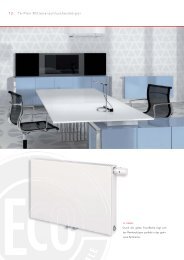
![Catalogus [pdf; 6.35 MB] - Vogelundnoot.com](https://img.yumpu.com/48248733/1/184x260/catalogus-pdf-635-mb-vogelundnootcom.jpg?quality=85)
![Technische Informationen KONTEC Modernisierung [pdf; 0.21 MB]](https://img.yumpu.com/48194356/1/184x260/technische-informationen-kontec-modernisierung-pdf-021-mb.jpg?quality=85)
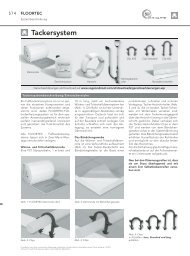
![Accessories [pdf; 0.22 MB] - Vogelundnoot.com](https://img.yumpu.com/47711728/1/184x260/accessories-pdf-022-mb-vogelundnootcom.jpg?quality=85)

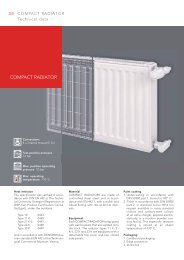
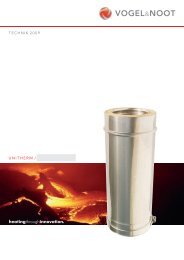

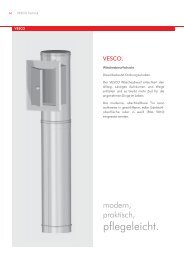
![Montageanleitung SECO [pdf; 0.90 MB] - Vogelundnoot.com](https://img.yumpu.com/45428518/1/184x260/montageanleitung-seco-pdf-090-mb-vogelundnootcom.jpg?quality=85)
